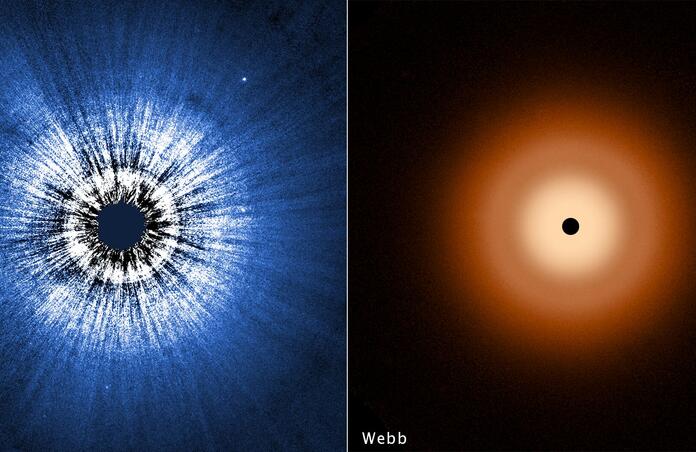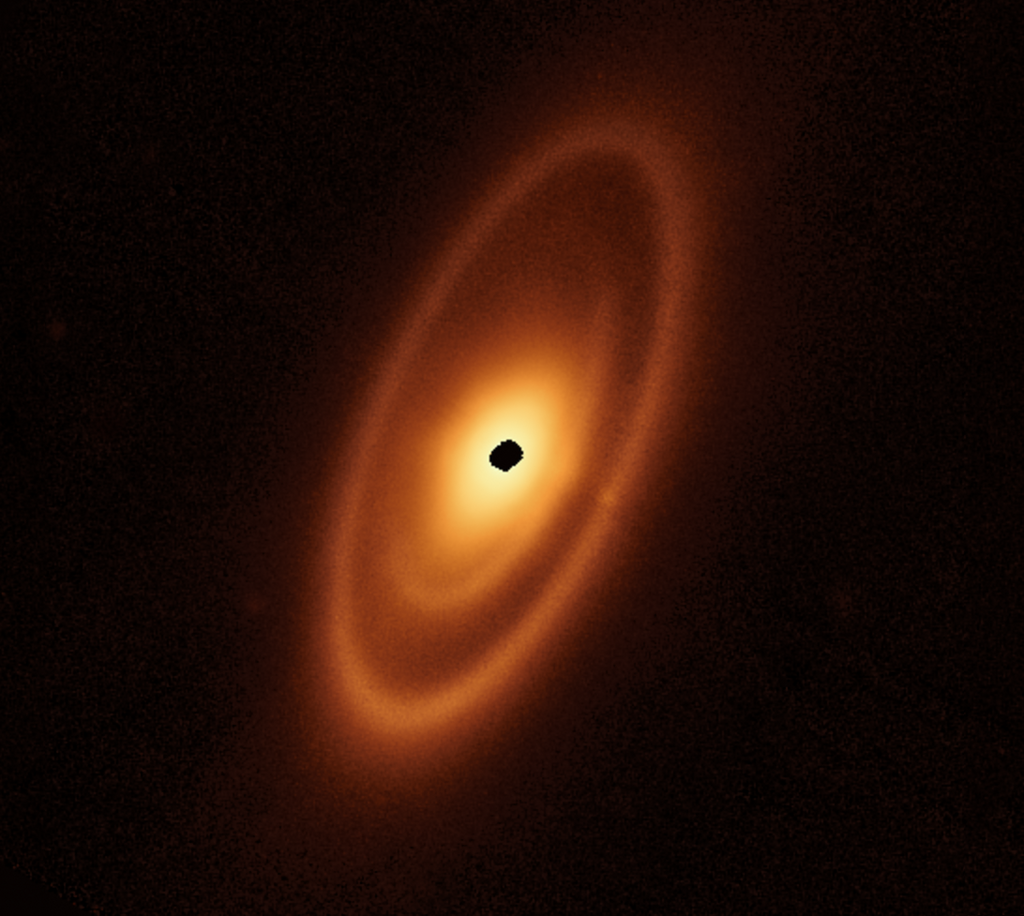Surprisingly smooth debris disk suggests no planets around Vega

A group of astronomers based at the University of Arizona, Tucson have used NASA’s Hubble and James Webb Space Telescopes for a detailed look at the debris disk that surrounds Vega, spanning nearly 100 billion miles in diameter. The observations showed a surprisingly smooth debris disk, suggesting that no planets have formed around the bright star.
Vega is located 25 light years away from earth in the Lyra constellation and is twice as massive as the sun. Its magnetic pole is pointed directly at us, which in combination with its rapid rotation and close distance to earth makes it one of the brightest stars in the northern sky. Vega provided the first evidence for material orbiting a star as potential homes for life. This was first hypothesised in 1775 by Immanuel Kant, however the first observational evidence wasn’t collected for another 200 years.
A shell or disk of dust extending twice plutos orbital radius from Vega was observed through an excess of infrared light from warm dust using NASA’s Infrared Astronomer Satellite. A dust ring was subsequently mapped out in 2005 using NASA’s Spitzer Space Telescope, confirmed by further observations using several sub-millimeter telescopes, however none could see much detail.
However, the main surprise is that there are no clear gaps seen in this debris disk, meaning that no large planets have carved their orbital paths through the disk.
"Between the Hubble and Webb telescopes, you get this very clear view of Vega. It's a mysterious system because it's unlike other circumstellar disks we've looked at," said Andras Gáspár of the University of Arizona, a member of the research team. "The Vega disk is smooth, ridiculously smooth."
JWST probes in the infrared, observing the glow from the particles which make up the disk as sand-sized grains which dance around the central star. Hubble observes an outer halo of the disk, consisting of minute particles reflecting sunlight. This layered distribution of dust is due to the pressure of starlight moving out smaller grains faster than larger ones.
"Different types of physics will locate different-sized particles at different locations," said Schuyler Wolff of the University of Arizona team, lead author of the paper presenting the Hubble findings. "The fact that we're seeing dust particle sizes sorted out can help us understand the underlying dynamics in circumstellar disks."
The disk has a faint gap at around 60 AU from the star, however, this is caused by smaller dust particles being blown further away by stellar radiation rather than a planet. Apart from this the disk is very smooth throughout until it is overpowered by the glare of Vega, suggesting that there are no planets down to Neptune-mass in large orbits.
"We're seeing in detail how much variety there is among circumstellar disks, and how that variety is tied into the underlying planetary systems. We're finding a lot out about the planetary systems—even when we can't see what might be hidden planets," added Su. "There's still a lot of unknowns in the planet-formation process, and I think these new observations of Vega are going to help constrain models of planet formation."
Young stars in the process of forming accrete material from a disk of dust and gas that is the remnant of the cloud from which they are forming, that is subsequently flattened. Such disks were discovered around a number of newly forming stars by Hubble in the mid 1990s, becoming the likely regions for planet formation, migration and destruction.
Mature stars such as Vega have dusty disks enriched by collisions between orbiting asteroids and debris from evaporating comets. These bodies can survive up to the present age of Vega which is 450 million years old. Similarly, dust in our solar system is replenished by minor bodies which release dust at around 10 tons per second. This dust is moved around by planets, providing a way to detect the presence of planets without directly observing them.
"Vega continues to be unusual," said Wolff. "The architecture of the Vega system is markedly different from our own solar system where giant planets like Jupiter and Saturn are keeping the dust from spreading the way it does with Vega."

A star that can be used for comparison is Fomalhaut, a nearby star with roughly the same distance, age and temperature as Vega. However, Fomalhauts circumstellar architecture is vastly differs to Vegas, it possessing three nested debris belts. It has been proposed that there are planets around Fomalhaut which gravitationally influence the dust to form rings, despite there being no planets identified as of yet.
--
Cover image: NASA, ESA, CSA, STScI, S. Wolff (University of Arizona), K. Su (University of Arizona), A. Gáspár (University of Arizona)
Journal sources:
S. G. Wolff et al. Deep Search for a scattered light dust halo around Vega with the Hubble Space Telescope. arXiv (2024). arxiv.org/pdf/2410.24042
K. Y. L. Su et al. Imaging of the Vega Debris System using JWST/MIRI, arXiv (2024). arxiv.org/pdf/2410.23636
